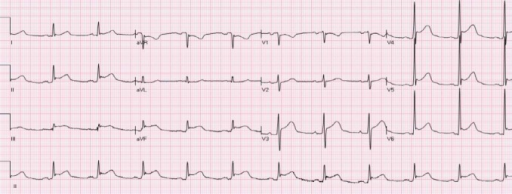Playlist
Show Playlist
Hide Playlist
Constrictive Pericarditis: Pathogenesis
-
Slides Pericardial Disease Constrictive Pericarditis Cardiovascular Pathology.pdf
-
Download Lecture Overview
00:01 The last of the topic of pericardial disease is one in which I need you to think of it is being a continuation. 00:07 You won’t underestimate this lecture nor do you overestimate it. You get the fundamentals and once you do, then you’ll understand the concept of constrictive pericarditis. 00:19 How many times have you thought yourself, “My goodness, this seems like a restrictive cardiomyopathy or a restricted type of disease". But then, you have choices of whether it being constrictive or not? Well, let’s make sure that we’re completely clear about your diagnosis of constrictive versus restrictive. 00:39 And what that actually means? So, whats constrictive? What is it? Point being chronicity. 00:48 If it’s a number one thing that you take out of this entire lecture for constrictive pericarditis. Chronicity. 00:54 What do you mean chronicity? A chronicity, well, remember when we talk about rheumatic heart disease. 01:00 Remember when we talk about cirrhosis. Remember when we talk about the concept the fibrosis. 01:06 What does that mean Dr. Raj? It means the following. 01:09 When we had rheumatic heart disease, initially, early on, you had vegetation’s that results in working of valvular heart diseases on the left side most commonly. 01:18 Early on, acutely, It was regurge. And it was regurge. Vegetations. But then, what happen chronically? While you introducing damaged, goods. 01:29 And so therefore, when something it’s damage, what happens? You have to go through repair process. 01:33 Tell me about cirrhosis. With cirrhosis, well, cirrhosis end stage of liver disease. Maybe it was alcohol. 01:38 Maybe it was autoimmune. Maybe it was viral. Maybe it was not alcoholic. Right? And so therefore, anyone of those at some point results in a chronic type of condition of fibrosis of the liver. 01:51 Or if its honeycomb appearance of youlongo on chest x-ray, what does that mean? Increased fibrotic deposition of the septa, right? So, when you say chronicity, and when there’s initial damage, you are going to start depositing more, more of your college of resulting increase fibrosis. Is that clear? As far add bengay? Concept: once you do, then you’ll understand constrictive. Okay? Because you can’t bring in constrictive immediately if you don’t have the fibrosis. 02:24 Maybe you can have restrictive granted, alright? So there’s certain amount of restriction that might be taking place. 02:29 But still not fully fibrotic, not fully calcified. Once that occurs in its fully calcified on fibrotic, now, what is the description? It’s a fact that, oh my goodness, you have a chick in an egg that want’s to now explode. 02:45 It’s ready to come out into the world. Okay. But, it’s in an egg. Okay granted. You want that egg to break So that, you know, the creature has freedom. But that’s not how the heart works. 02:58 There has to be proper expansion granted. My goodness, it should never be in eggshell. 03:03 Do you get the point. So think of the heart encased in a inexpendable eggshell. That is not a good feeling. 03:10 In addition, think of the eggshell was being white, so that you’ll understand that is severe, severe constriction. 03:17 That’s a lot of fibrosis and calcification. How incredibly convenient that its calcium and its white. 03:24 Let’s continue. The scarred or calcified pericardium squeezes, constricts the heart. 03:31 Is it restrictive. Of course it is. But clinically speaking, you must diagnose as just being what? Constrictive. 03:39 Are we seeing these now? So as I said earlier, how much attention do you pay for this lecture? While, quite a bit so that you understand the concept. 03:48 But once you do, then it becomes a very easy diagnosis as you can see. 03:52 Talk about constrictive. So what these errors are showing are those parts of the pericardium in which it is undergoing pericardial calcification? You see how incredibly white opaque is the pericardium has now become? This is constrictive. 04:07 Did this occur acutely? No, no, no. Chronicity. 04:10 With chronic, chronic build-up of fibrosis and calcification, dystrophic, right. Damage first then accumulation of calcium. You’re going to find that increased opacity as we see here in our chest x-ray. 04:22 You have the basically AP view don’t you? Anterior, posterior view.
About the Lecture
The lecture Constrictive Pericarditis: Pathogenesis by Carlo Raj, MD is from the course Pericardial Disease: Basic Principles with Carlo Raj.
Included Quiz Questions
Which of the following conditions have a similar clinical presentation as constrictive pericarditis?
- Restrictive cardiomyopathy
- Restrictive pericarditis
- Pericardial tamponade
- Constrictive cardiomyopathy
- Dressler syndrome
Which of the following is NOT likely associated with constrictive pericarditis?
- Acute fibrosis of the pericardium
- Dystrophic calcification of the pericardium
- Chronic scarring of the pericardium
- Decreased cardiac output
- Increased thickening of the pericardium
Customer reviews
5,0 of 5 stars
| 5 Stars |
|
5 |
| 4 Stars |
|
0 |
| 3 Stars |
|
0 |
| 2 Stars |
|
0 |
| 1 Star |
|
0 |




